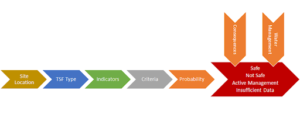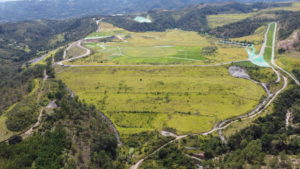Tailings Hazard
Overview
Tailings storage facilities are a common and widely used method to store the waste material generated from many forms of mining activity. Often such facilities include dams and other structures that could remain in place well after active mining operations have ceased. These legacy sites may still require maintenance and monitoring to ensure the safety of the structure.
In August of 2020, the mining industry released the Global Industry Standard on Tailings Management (GISTM) as a response to the catastrophic failure of a tailings storage facility (TSF) in Brazil that occurred in 2019. Included in this document is a provision that facilities considered closed safely have met the standards because they would be considered similar to landforms that are largely inert and pose little risk to humans and the environment [1].
The purpose of this project was to develop a method to identify legacy facilities that are eligible for safe closure status. The method proposed was a decision matrix based on facility type and location, structural stability indicators, hazard indicators, water management, and consequence of failure. Newmont Corporation has committed to incorporating the GISTM for its facilities. With numerous legacy facilities to manage in addition to active mines around the world, determining closed safe status for legacy facilities would help Newmont achieve their goal of implementing the GISTM. Furthermore, identifying facilities that are closed safely can help Newmont prioritize efforts and allocate resources among facilities still requiring management.
A preliminary decision matrix was created and tested against the Equity Silver Mine legacy site which has a TSF with permanent water cover. The initial testing revealed the need for improvements. Such improvements include determining a probability of failure from the structural stability indicators, refining criteria, expanding criteria and useability to other locations and types of TSF, and providing an automated and user-friendly computer-based program to quickly obtain results. However, the decision matrix allows users to obtain a big-picture assessment of the TSF and indicates those areas where structural improvements could be made to reach a safe closure condition.
References
[1]Global Tailings Review, “Global Tailings Review.org,” August 2020. [Online]. Available:
https://globaltailingsreview.org/. [Accessed 19 September 2020].
Live Zoom Chat
Use the link below to join us live from 8:00 – 10:30 a.m. on December 3.
https://mines.zoom.us/j/94676557939?pwd=UzBQNjJYTjFYT1c5RHo4RnhCQTVwdz09
Please use passcode: 120068
Or iPhone one-tap: 16699006833,94676557939# or 12532158782,94676557939#
Or Telephone:
Dial: +1 669 900 6833 (US Toll) or +1 253 215 8782 (US Toll) Meeting ID: 946 7655 7939
Team Members
- Shannon Herstein
- Jessica DiCaprio
- Elle Leuth
- Kori Davis
The Client
- Newmont
Acknowledgements
Project Advisor: Robin Bullock
Newmont Advisors: Kim Morrison
Manuel Aparicio
Brett Byler
Video
Elevator Pitch
It is estimated that the mining and processing of mineral ores generate approximately 1.8 billion tons of mineral processing waste, also called tailings, each year in the United States [1].
Tailings, often stored in tailings storage facilities (TSF) which often consist of containment structures to confine the material. Some facilities include permanent water cover to prevent production of acid rock drainage. Unfortunately, TSFs have a failure rate of over 1% over the last 100 years. [2]. In an effort to improve and standardize tailings management globally, the mining industry produced a Global Industry Standard on Tailings Management (GISTM), released in 2020. For sites that are no longer operations, also known as legacy sites, showing that the facility has been safely closed would show that the global standard has been met.
This project established a method to classify legacy tailings facilities as closed safely to support Newmont’s goal of implementing the global standard. Such a determination will help Newmont prioritize sites where the global standard has not been met, allocate resources, and identify steps needed to stabilize potentially unsafe legacy sites and achieve safe closure.
References
[1] Collins R. J. and S. K. Ciesielski. Recycling and Use of Waste Materials and By-Products in Highway Construction. National Cooperative Highway Research Program Synthesis of Highway Practice 199, Transportation Research Board, Washington, DC, 1994.
[2] Zongjie Lyu, Junrui Chai, Zengguang Xu, Yuan Qin, and Jing Cao, “A comprehensive review on reasons for tailings dam failures based on case history.,” Advances in Civil Engineering, vol. 2019, p. 18, 2018.
Design Approach
To meet these criteria of safe closure, the decision matrix focuses on four general indicators: structural stability, geologic hazards, consequences, and water management. The matrix was developed in several steps as listed below:
- Identify potential legacy sites for testing and calibration.
- Determine the relevant indicators and criteria for safe closure based on Newmont’s definition of safe closure
- Compile criteria from regulations and guidelines from the United States of America and countries where legacy TSFs proposed for decision matrix development are located
- Generate a decision matrix that accounts for location, facility type, stability, and consequence of failure
- Test the matrix using legacy sites
- Determine issues with matrix and revise
To develop our decision matrix, the team began by narrowing down the key features that may be looked at when deciding if a TSF is closed safely and the Newmont definition of safe closure [1]. The decision matrix also needed to account for geographic and climate variability and relevant regulations. The general process is shown in Figure 1. Together, the probability of failure, consequence of failure, and water management would determine the classification of safe, not safe, active management, or need additional data.

Figure 1. General overview of decision matrix process.
References
[1] K. Morrison, Slide describing Newmont definition of safe closure, 2020.
Design Solution
Newmont criteria along with industry standard and GISTM research has been compiled by the Golden Girls into the decision matrix. Indicators for the matrix are directly below:
|
Indicators |
Criteria |
Determination |
Tolerance |
|
Structural Stability
|
Deformation: Long-term Undrained |
Test Effective Strength |
Minimum Factor of Safety 1.5 |
|
Deformation: Short-term Undrain (potential loss of containment) |
Test Consolidated Undrained Strength |
Minimum Factor of Safety 1.5 |
|
|
Deformation: Short-term Undrain (no potential loss of containment) |
Test Consolidated Undrained Strength |
Minimum Factor of Safety 1.3 |
|
|
Phreatic Surface |
Phreatic Surface Data |
To be determined |
|
|
Liquification |
Model of Shear Stress and Steady State Strength |
Dependent on Slope versus Shear Stress |
|
|
Internal Erosion |
Observation |
To be determined |
|
|
Hazards: Earthquakes |
Withstand 10,000 Year Event |
Published Studies |
Able to withstand 10,000 year event |
|
Hazards: Flooding |
Withstand 10,000 Year Event |
Published Studies |
Able to withstand 10,000 year event |
The GISTM defines safe closure as one that:
“does not pose ongoing material risks to people or the environment which has been confirmed by an ITRB or senior independent technical reviewer and signed off by the Accountable Executive” [1]
Newmont criteria:
- ponded water will not propagate a failure or uncontrolled release of contents
- contents do not and cannot flow and do not rely on a barrier structure to prevent and uncontrolled release
- contents do not and cannot migrate or pipe through the structure or foundation
- conditions that could violate the previous three criteria will not develop in the future
The table below show the team’s matrix connecting probability of failure and consequence rating from the the GISTM:
|
Probability of Failure |
|||
|
Consequence Rating (GISTM) |
0% – 2% |
> 2 % – ≤ 10% |
> 10% – 100% |
|
low |
safe |
safe |
safe |
|
significant |
safe |
active management |
not safe |
|
high |
active management |
not safe |
not safe |
|
very high |
active management |
not safe |
not safe |
|
extreme |
active management |
not safe |
not safe |
*A facility can be classified as having insufficient information if the consequence rating or information supporting an estimate or failure is not available.
Details on what each classification means are as follows:
Classifications are defined as
- Safe: meets Newmont criteria
- Not Safe: does not meet Newmont criteria
- Active Management: considered safe, however, the TSF either has high consequences if a failure occurs or some sort of active management such as water management remains necessary
- Insufficient Data: data are insufficient to support a decision
The team’s working matrix with detailed social and water management criteria can be found here
References
[1]Global Tailings Review, “Global Tailings Review.org,” August 2020. [Online]. Available:
https://globaltailingsreview.org/. [Accessed 19 September 2020].
Next Steps

courtesy of Kim Morrison (Newmont, 2020)
Goals for the spring 2021 semester are as follows:
- Refine matrix criteria
- Develop a relationship between probability and consequence rating
- Improve user friendliness of matrix (possibly automation)
Meet the Team
Shannon Herstein - Project Manager
 2nd Bachelors Degree – B.S. Civil Engineering
2nd Bachelors Degree – B.S. Civil Engineering
specific interest in water projects
Spring ‘20 semester project: San Luis Mine water treatment project
Academic Interests: using remote sensing, imagery, and data to evaluate tailings storage facility stability
Elle Lueth - Project Engineer

B.S. Civil Engineering
Academic Interests: transportation and geotechnical engineering
Past experience: transportation engineering and soil analysis
Kori Davis - Communications Lead

B.S. Environmental Engineering
Academic Interests: Hydrology, solid waste management, environmental permitting
Personal Interests: Hiking, music and art
Jessica DiCaprio - Assistant Project Manager

B.S. Environmental Engineering
Minor in Public Affairs (McBride Honors Program)
Academic Interests: environmental chemistry, hydrology, consulting
Personal Interests: hiking, trail running, skiing, photography